Related Research Articles
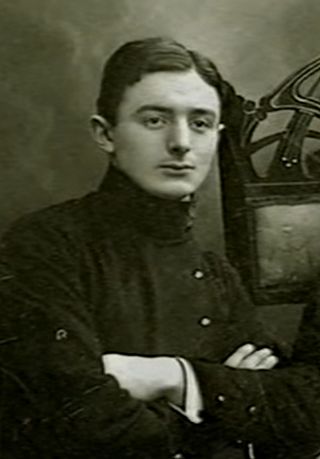
Dziga Vertov was a Soviet pioneer documentary film and newsreel director, as well as a cinema theorist. His filming practices and theories influenced the cinéma vérité style of documentary movie-making and the Dziga Vertov Group, a radical film-making cooperative which was active from 1968 to 1972. He was a member of the Kinoks collective, with Elizaveta Svilova and Mikhail Kaufman.
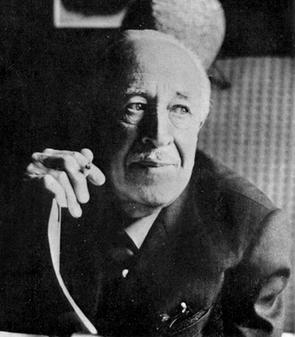
Lev Vladimirovich Kuleshov was a Russian and Soviet filmmaker and film theorist, one of the founders of the world's first film school, the Moscow Film School. He was given the title People's Artist of the RSFSR in 1969. He was intimately involved in development of the style of film making known as Soviet montage, especially its psychological underpinning, including the use of editing and the cut to influence the emotions of audience, a principle known as the Kuleshov effect. He also developed the theory of creative geography, which is the use of the action around a cut to connect otherwise disparate settings into a cohesive narrative.
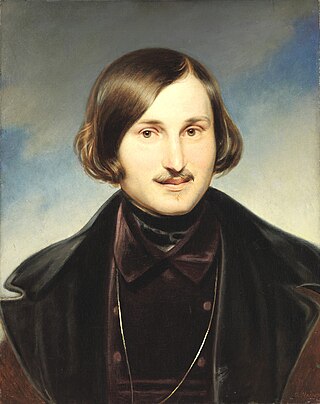
Nikolai Vasilyevich Gogol was a Russian novelist, short story writer, and playwright of Ukrainian origin.

Theresienstadt Ghetto was established by the SS during World War II in the fortress town of Terezín, in the Protectorate of Bohemia and Moravia. Theresienstadt served as a waystation to the extermination camps. Its conditions were deliberately engineered to hasten the death of its prisoners, and the ghetto also served a propaganda role. Unlike other ghettos, the exploitation of forced labor was not economically significant.

Yevgeni Franzevich Bauer was a Russian film director of silent films, a theatre artist and a screenwriter. His work had a great influence on the aesthetics of Russian cinematography at the beginning of the 20th century.
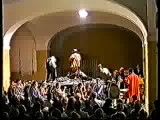
Der Kaiser von Atlantis oder Die Tod-Verweigerung is a one-act opera by Viktor Ullmann with a libretto by Peter Kien. They collaborated on the work while interned in the Nazi concentration camp of Theresienstadt (Terezín) around 1943. The Nazis did not allow it to be performed there.

Theresienstadt. Ein Dokumentarfilm aus dem jüdischen Siedlungsgebiet, unofficially Der Führer schenkt den Juden eine Stadt, was a black-and-white projected Nazi propaganda film. It was directed by the German Jewish prisoner Kurt Gerron and the Czech filmmaker Karel Pečený under close SS supervision in the Theresienstadt concentration camp, and edited by Pečený's company, Aktualita. Filmed mostly in the autumn of 1944, it was completed on 28 March 1945 and screened privately four times. After the war, the film was lost but about twenty minutes of footage was later rediscovered in various archives.
Karin Friedrich is a German historian, a professor in history at the University of Aberdeen King's College.
Apparatus. Film, Media and Digital Cultures of Central and Eastern Europe is a bi-annual open-access academic journal with double blind peer-review. Apparatus is supported by the DFG, hosted by Freie Universität Berlin and edited by Dr Natascha Drubek. The first issue was published in September 2015. Apparatus publishes in the native languages of the region as well as in English. The editorial board includes scholars from the US, Europe and Russia.
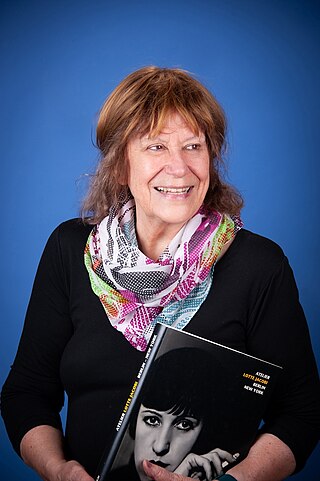
Helga W. Kraft, is a German-American Professor of Germanic Studies, Emerita.
Hyperkino is a standardized system of referencing and annotating films on digital carriers – attaching related content and analysis to individual frames. The name of the method, Hyperkino, is based on the intertwining of the concepts of textual criticism and hypertext.

Ljiljana Filipović is a Croatian author and philosopher.

Géza Pálffy is a Hungarian historian, full (university) professor. He has long been active in research of the relationship between the Habsburg monarchy and Kingdom of Hungary in the 16–17th centuries. He works as a scientist both in Hungary and around the world, and has published in several languages: English, German, Slovak, Croatian, Romanian, French, Russian, Italian, Czech, Turkish and Hungarian.

After Death is a 1915 Russian film directed by Yevgeni Bauer.
During World War II, the Theresienstadt concentration camp was used by the Nazi SS as a "model ghetto" for deceiving Red Cross representatives about the ongoing Holocaust and the Nazi plan to murder all Jews. The Nazified German Red Cross visited the ghetto in 1943 and filed the only accurate report on the ghetto, describing overcrowding and undernourishment. In 1944, the ghetto was "beautified" in preparation for a delegation from the International Committee of the Red Cross (ICRC) and the Danish government. The delegation visited on 23 June; ICRC delegate Maurice Rossel wrote a favorable report on the ghetto and claimed that no one was deported from Theresienstadt. In April 1945, another ICRC delegation was allowed to visit the ghetto; despite the contemporaneous liberation of other concentration camps, it continued to repeat Rossel's erroneous findings. The SS turned over the ghetto to the ICRC on 2 May, several days before the end of the war.
Hans-Erich Volkmann is a German historian, whose works primarily deal with the history of Germany from the 19th–20th century, and particularly how it relates to the East European states. He is one of the authors of the first volume of Germany and the Second World War. He has also been one of the editors of Militärgeschichtliche Zeitschrift.
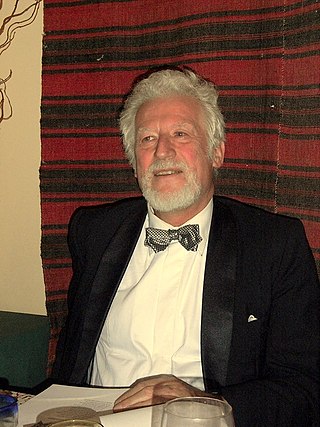
Helmut Birkhan is an Austrian philologist who is Professor Emeritus of Ancient German Language and Literature and the former Managing Director of the Institute for Germanic Studies at the University of Vienna.
Anna Hájková is a Czech-British historian who is currently a faculty member at the University of Warwick. She specializes in the study of everyday life during the Holocaust and sexuality and the Holocaust. According to Hájková, "My approach to queer Holocaust history shows a more complex, more human, and more real society beyond monsters and saints."
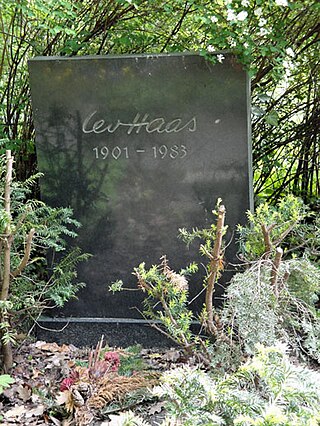
Leo Haas was a German painter, graphic artist, draughtsman and caricaturist.

Emil Utitz was a Czech philosopher and psychologist of Jewish descent. He was educated in Prague, where he was a classmate of Franz Kafka. After studies in Munich, Leipzig, and Prague, he became a professor in Rostock, and from 1925 was Chair of Philosophy at the University of Halle-Wittenberg. After his forced retirement in 1933, he became a professor in Prague. In 1942, he was deported to Theresienstadt Ghetto, where he was head of the library. After the liberation of Theresienstadt in 1945, he returned to Prague. Utitz died in Jena in 1956, while travelling through East Germany to give lectures.
References
- ↑ ""Мы хотим перешагнуть границы языков" | Colta.ru". www.colta.ru. Retrieved 2016-12-19.
- ↑ "US Holocaust Memorial Museum Fellow to Speak at CU – Boulder Jewish News". boulderjewishnews.org. 14 January 2014. Retrieved 2016-12-19.
- ↑ "Terezín 2014 | Film Conference in Terezín in Sept. 2014". www.terezin2014.com. Retrieved 2016-12-19.
- ↑ Germany, SPIEGEL ONLINE, Hamburg (14 January 2015). "SS-Propagandafilm "Theresienstadt": 90 Minuten Lüge". Der Spiegel. Retrieved 2016-12-19.
{{cite news}}: CS1 maint: multiple names: authors list (link) - ↑ Lühmann, Hannah; Terezín (2014-09-09). "Propagandafilme aus Theresienstadt: Wahrheit steckt auch in Lügenbildern". Frankfurter Allgemeine Zeitung. ISSN 0174-4909 . Retrieved 2016-12-19.
- ↑ "Digitale Bibliothek - Münchener Digitalisierungszentrum". daten.digitale-sammlungen.de. Retrieved 2016-12-19.
- ↑ Tippner, Anja (2001). "Review of Gogol's eloquentia corporis. Einverleibung, Identität und die Grenzen der Figuration. (Slavistische Beiträge, Bd. 374)". Zeitschrift für Slavische Philologie. 60 (2): 443–448. JSTOR 24003189.
- ↑ Postoutenko, Kirill (2000). "Review of Gogol's eloquentia corporis: Einverleibung, Identitaet und die Grenzen der Figuration". The Slavic and East European Journal. 44 (2): 319–320. doi:10.2307/309969. JSTOR 309969.
- ↑ "Recovered, discovered, and restored: DVDs, Blu-rays, and a book". Observations on film art. Retrieved 2016-12-19.
- ↑ Binder, Evi (December 2012). Natascha Drubek: Russisches Licht. Von der Ikone zum frühen sowjetischen Kino. Wien [etc.]: Böhlau, 2012. 527 S., zahlr. Abb. = Osteuropa medial, 4. Böhlau Verlag Köln Weimar. ISBN 978-3-412-20456-3 . Retrieved 2017-07-17.
{{cite book}}:|website=ignored (help) - ↑ Bremer, Thomas. "Rezensionsartikel". Theologische Revue. 111 (5): 433.
- ↑ Zehnder, Christian (2013). "Rezensionsartikel". Wiener Slawistischer Almanach. 71: 389–402.
- ↑ Engel, Christine (2013). "Rezensionsartikel". Osteuropa. 64: 8.